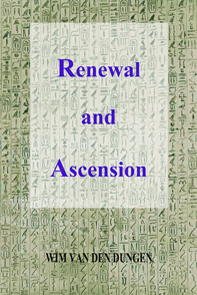The Adoration of Re
Hymn to the Rising Sun
"Hymn to Re when he
rises."
from the Papyrus of Ani (ca.1250 BCE)
by Wim
van den Dungen
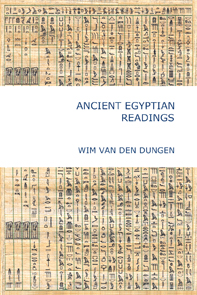 |
The translation of
The Adoration of Re is part of my
Ancient Egyptian Readings (2016), a POD publication in paperback
format of all translations available at maat.sofiatopia.org.
These readings span a period of thirteen centuries, covering all
important stages of Ancient Egyptian literature. Translated from
Egyptian originals, they are ordered chronologically and were
considered by the Egyptians as part of the core of their vast
literature.
The study of the sources, hieroglyphs, commentaries and pictures
situating the text itself remain on the website at no cost. |
1. Sources :
Papyrus of Ani.
2. The Book of the Dead.
3. The Papyrus of the
Adoration of Re.
4. Hieroglyphs of the
Hymn.
5. English Translation of
the Hymn.
6. Commentary.
1. The Sources
The Papyrus of Ani,
found at Thebes, written in cursive hieroglyphs and illustrated with
color vignettes, was purchased by the Trustees of the British Museum run
by Sir E.A.Wallis Budge in 1888, where it remains today in the Department
of Egyptian Antiquities. The material
itself has three layers of papyrus, provided by plants measuring 4.5
inches in the stalks. When unrolled, it became darker and certain sections
shrunk.
Apparently written by at least three scribes, the vignettes call
for fewer artists. The titles of the chapters, rubrics, catch-phrases etc.
are in red. At times the text crowds because the artist occupied too much
space. The vignettes were probably drawn before the text was written. The
different section of the papyrus were not all originally written for Ani,
 , for in several
places his name is entered by a later hand. Such additions do not occur in the first 16 feet
and 4 inches. The text has errors, like two copies of a chapter. , for in several
places his name is entered by a later hand. Such additions do not occur in the first 16 feet
and 4 inches. The text has errors, like two copies of a chapter.
For obvious reasons, the original 3200-year-old papyrus cannot be studied.
Photographs of it were published as Dondelinger, E. (edit) : Codices
Selecti, Akademische Druck & Verlagsanstalt - Graz, vol. LXII,
1976. The first full-color facsimile was published by Sir Peter Le Page
Renouf in 1890. Budge published a corrected hieroglyphic edition without
vignettes in 1895 and 1910. A reproduction in a single volume of the
original facsimile edition, with hieroglyphic text and vignettes together
once more, was published by Chronicle Books in 1994 & 1998. Translations were by
Faulkner, with minor changes added by Goelet (Faulkner died before
finishing his work on the Book of the Dead).
The Papyrus of Ani is
undated and no facts concerning the life of Ani are given. We know he was
a scribe, an accountant and an overseer of the granary at Thebes. Ani
probably lived during the XIXth Dynasty (ca. 1292 - 1188 BCE), but earlier
dates have been suggested (ca. 1450 BCE). But as in the XVIIIth Dynasty,
N23 tends to be replaced by N21 (cf.
Gardiner,
Sign-list), and the latter is found in the text, an early XIXth Dynasty
dating seems appropriate.
Ani's official, full title was :

"Royal Scribe ! True Scribe ! Accountant of the Divine Offerings of all the
gods. Overseer of the Granary of the Lords of Abydos. Scribe of the
Divine Offerings of the Lords of Thebes."
The Papyrus of Ani is the most beautifully illuminated surviving ancient papyrus
and contains one of the many versions of the Ancient Egyptian "prt m hrw",
"peret-em-heru"
or
"The
Book of Coming Out by Day", containing spells
mainly used for mortuary purposes, in particular the Judgment of the Dead, but also for various magical operations
in this-life (like protection, morality) & the afterlife (like transformations &
ascensions).
The original Papyrus of Ani
measured 78 feet long by 1 foot 3 inches deep. Unfortunately, Wallis Budge
-in tune with the mentality of the majority of his peers at large- cut the original
using the "yardstick" method, dividing it into thirty-seven sheets of
relatively even length, thus disfiguring the flow of the original scroll.
By today's standards, keeping the smallest item intact, such rough
handling can no longer be appreciated. Only one of these thirty-seven segments
lacks a vignette of some kind, while most have vignettes spanning the
whole height of the papyrus.
2 The Book of
the Dead
The Book of the Dead
is a group of so-called "mortuary spells", mostly written on
papyrus. At least 24 manuscripts are extant, with considerable variations
between them. The earliest were found on mummy cloths and coffins of the
beginning of the New Kingdom (ca. 1539 - 1075 BCE), but the book remained
popular during the Third Intermediate Period (ca. 1075 - 664) and the Late
Period (664 - 30 BCE). The collection circulated throughout Egypt, with Thebes
at the head. Beginning with the reign of Pharaoh Tuthmosis III (ca. 1479 - 1426
BCE), spells began to be used by officials and commoners alike. The Papyrus
of Ani, besides being one of the most complete of its kind, is famous for
its exquisite vignettes.
Willem Pleyte, Naville, Budge, Allen (who published a list of all extant
manuscripts) and others have identified new Chapters, bringing the present
number of extant Chapters of the Book of the Dead at 192.
The origins of this book can be traced to the
Pyramid Texts, appearing
at the end of the Fifth Dynasty (ca. 2400 BCE). These texts were solely for the
benefit of the royals. A few centuries later, these spells were adapted for
private use and incorporated into a group of new spells, the Coffin Texts,
to be employed by anyone who could afford a sarcophagus. By the Early New
Kingdom (ca. 1550 BCE), these texts were slowly replaced by the spells known
today as the Book of the Dead.
In 1842, Lepsius published
the lengthy and well-illustrated Turin Ptolemaic Papyrus of Iuwefankh as "Totenbuch",
fixating the title and the numbering of the chapters in
use to this day. The Ancient Egyptians called this collection, with its ever-changing and recombined
sections, "The Book of Coming Out by Day", after the heading of Chapter 1,
often preferred at the beginning (cf. "peret-em-heru").
"Here begin the praises and glorifications,
going out and in the domain of god,
having benefit in the beautiful West,
coming out by day,
taking any shape he likes,
playing at Senet, sitting in a booth,
and coming out as a living soul.
After he has arrived in port,
Osiris, the scribe Ani, said :
'It is beneficial to him
who does it on Earth.'"
Book of the Dead,
Chapter 17 (Ani & Nebseni), my italics.
This apt title covers the main theme of the collection : entering
the Land of the Dead, the Kingdom of Osiris through the Western Gate, descending
into the darkness of this supreme Lunar deity, actually coming out into
the light of the Night Sun. In the
Amduat, the Twelve Hours
of the night
regenerate the depleted life-force of Re. But here, the deceased enters the Duat
to be "justified", i.e. vindicated and thus worthy to become a servant of
Osiris, enjoying the
Light of Re as he travels on his bark in the Land of the Dead. In order to be
justified, on had to pass the Judgment of the Dead. This Weighing Scene,
balancing the heart with the Feather of Truth, plays therefore
the central role in the book. Let us look at it in some detail.
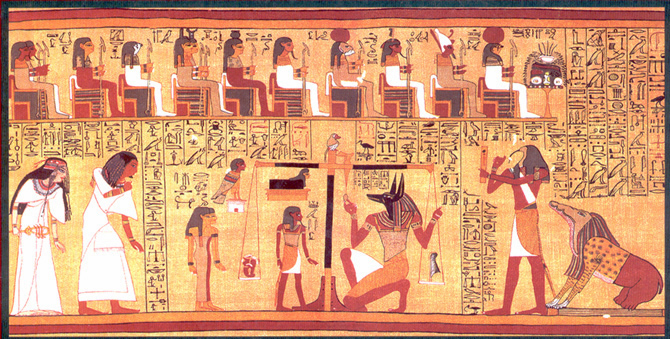
Papyrus of Ani, Plate 3.
|
TRANSLATION
(the hieroglyphs start above the "meskhen" and face
right) :
"Osiris, the scribe Ani, said : 'O my heart which I had from my
mother ! O my
heart which I had from mother ! O my heart of my different ages ! May there be nothing
to resist me at the judgment. May there be no opposition to me from the
assessors. May there be no parting of You from me in the presence of
him who keeps the scales ! You are my Ka within my body, which
formed and strengthened my limbs. May You come forth to the place of
happiness whereto I advance. May the entourage not cause my name to
stink, and may no lies be spoken against me in the presence of the god
! It is indeed well that You should hear !'"
(Anubis watches a small text-line facing left) :
"Said he that is in the tomb : 'Pay attention to the decision of
truth and the plummet of the balance, according to its stance !'"
(the second part starts just above the right-hand beam of the balance,
faced by the Baboon", hieroglyphs facing left) :
"Said Thoth, the righteous judge, to the
Great Ennead, which is in the presence of Osiris : 'Hear ye, this
decision, in very truth ! The heart of Osiris has been weighed and his
Ba stands as a witness for him. His deeds are righteous in the Great
Balance, and no sin had been found in him. He did not diminish the
offerings in the temples, he did not destroy what had been made, he
did not go about with deceitful speech while he was on earth.'"
(the third large section starts in the far right corner, facing right)
:
"Said the Great Ennead of Thoth, who is in
Hermopolis : 'That which comes forth from your mouth is true. The
vindicated Osiris, the scribe Ani, is righteous. He has no sin, there
is no accusation against him before us. Amemet {the eater of the dead,
executing the second death} shall not be permitted to have power over
him. Let there be given to him the offerings which are issued in the
presence of Osiris, and may a grant of land be establised in the
Sekhet-Hetepu {the Field of Offerings} like for the followers of
Horus.'"
|
In this famous scene from the Papyrus of Ani, Ani and his wife enter the Hall of the Double Law or Double Truth
(divine versus human - good versus evil - eternal life versus second death,
etc.) to have Ani's heart, emblematic of conscience, weighed against the Feather of
Maat, emblematic of truth & justice.
On the left of the balance, facing Anubis, stands Ani's
"Shay" ("SAii") or "Destiny". Above Ani's Destiny is an object
called "meskhen" ("msxn"), a cubit with a human head
connected with Ani's place of birth. Behind "Shay" stand "Meskhenet",
presiding over the birth-chamber, and "Renenet", guiding the rearing of
children and called "Lady of Justification" (cf. the Litany
of Re). Above them (behind the "meskhen") is the Ba of Ani in the form of
a human-headed bird standing on a pylon. This left side summarizes the various
elements constituting Ani's life on earth :
-
where he was born (nature)
and how he was raised (nurture) ;
-
the destiny allotted to him
: "what is
fated" (Ptahhotep -
Maxims 12 & 33 -
Amenemope, chapter 7)
: Shay is also the god of the span of years and the prosperity one
may expect to enjoy - note the "meskhen" floats above Ani's
destiny (indeed, where one was born influences one's destiny) ;
-
Ani's heart ( ) : the epicentre
of the whole scene, symbolizing Ani's thoughts, intentions and conscience
during his lifetime on earth ; ) : the epicentre
of the whole scene, symbolizing Ani's thoughts, intentions and conscience
during his lifetime on earth ;
-
Ani's Ba : during his
lifetime, his soul was captured by the "net of the body" and it
made Ani happy if he invested in enduring thoughts & deeds in accord
with Maat - after the
mummification of the body, the Ba exists in a "spiritual body"
(the "sah") and witnessed the weighing, of which the final
direction of the lower constitutents of Ani depend (either a second
death or a vindication).
On the right of the balance, the left arm of Anubis is
above Maat's Feather (his tumb pointing to the words "the heart of
Osiris has been weighed") while his right hand touches the plummet
of the balance (at the end of the plumb-line).
On the centre of the beam of the balance sits a dog-headed ape (Baboon),
facing Thoth the recorder (who stands at Anubis' right side with the Monster of the
Netherworld behind him). Beneath the
right beam we find these words (spoken by Anubis, watching the
pumb-line) :
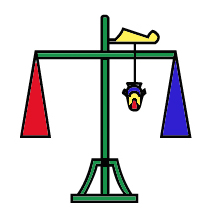
"Said he that is in the tomb :
'Pay attention to the decision of
truth
and the plummet of the balance, according to its stance !'"
This exhortation
summarizes the practice of wisdom found in Ancient Egypt,
as well as its philosophy of well-being and art of living happily &
light-heartedly (for the outcome of the weighing is determined by the
condition of the heart alone). In this short sentence, their "practical
method" springs to the fore : concentration,
observation, quantification (analysis, spatiotemporal flow, measurements)
& recording (fixating) with the sole purpose of rebalancing,
reequilibrating & correcting concrete states of affairs, using the
plumb-line of the various equilibria in which these actual aggregates of
events are dynamically -scale-wise- involved, causing Maat to be done for
them and their environments and the proper Ka, at peace with itself, to flow
between all vital parts of creation. The "logic" behind this
operation involves four rules :
-
inversion
: when a concept is introduced, its opposite is also invoked (the
two scale of the balance) ;
-
asymmetry
: flow is the outcome of inequality (the feather-scale of the
balance is a priori correct) ;
-
reciprocity
: the two sides of everything interact and are interdependent (the
beam of the balance) ;
-
multiplicity-in-oneness
: the possibilities between every pair are measured by one standard
(the plummet).
Above, in another register, are twelve gods, upon thrones before a table of
offerings of fruit, flowers, etc. Their names : Harmachis ("the great one
within his boat"), Atum, Shu, Tefnut ("Lady of the sky"), Geb, Nut,
Isis, Nephthys, Horus ("the great god"), Hathor ("Lady of
Amenta"), Hu (authoritative utterance) and Sia (understanding). In a way, they represent the heavenly bliss
awaiting the justified in the Kingdom of Osiris. Whether this final goal will be attained, will be
decided in this Hall of Truth.
Other visual dispositions of the same concept may be found, but the vignette of the Papyrus of Ani
outweighs them all qua beauty & excellence.

Various Weighing Scenes :
Papyrus BM 9901, Papyrus BM 10.472, Papyrus of Qenna, Wooden Ushabti
Box.
The central emblem is Maat's
Feather. It represents the standard of truth & justice immanent in
creation, but also the truth of the Declaration of Innocence made by the
deceased (Plate 31) before the tribunal of assessors (the hieroglyph for
"not" is in red), and thus by virtue of the rule of
"reversal", a "purging" of possible past crimes. Three
offences are repeated in the Judgment Scene :
-
never to diminish the
offerings made to the temples (against the Pantheon & the people) ;
-
never to destroy what had
been made (against the memorial of the ancestors) ;
-
never to speak deceitfully
(against truth & righteousness).
Wat does the text give us ? It
starts with Ani invoking his own conscience but also his mother, from whom he
received his heart (cf. the major role of woman in nurture, but also as
representing the sacred "matrix" of life). We also learn his
heart was linked with the Ka "within the body", the vital power
making and sustaining one's stride. Next, Anubis weighs Ani's heart against the
divine standard (the Feather) and Thoth confirms no sin is found and
the equilibrium of the Great Balance is established. Finally, the Ogdoad of
Hermopolis (headed by Thoth), confirms the sentence spoken and recorded by
Thoth and it is they -the chaos-gods- who lift the curse of the Monster or
Ani's "second death". Instead of being annihilated, Ani will be
allowed to enter the kingdom of Osiris because he is "maa-cheru"
("mAa - xrw"), i.e. vindicated, triumphant and justified !
What was the meaning of this afterlife scene to those still alive ? The
importance given to the heart could not be missed : it is a person's
conscience, determined by what he said (wrote) and did (how he lived), which
was deemed crucial. As Ptahhotep taught, just speech is the heart of a wise
transference of the best of the past to the best of today for the sake of the
future (so the memorial of the ancestors remains), as well as of the
continuous progress made over the generations. If we study Egypt's sapiental
literature, we do not encounter the notion a person may be
vindicated during his or her lifetime on earth. On the contrary, in the Old
Kingdom, a non-royal could only hope to endure without being immortalized. The
sage was always in the process of attaining the state of veneration,
except when his vital force left his physical vehicle. Then and only then
could veneration be a final station (a terminus). Although since the Middle Kingdom,
deceased commoners could be immortalized and deified as "Osiris-NN",
nobody attained this state during his or her lifetime. Only Pharaoh was a
living god on earth. Hence, even during his lifetime, Pharaoh was
"justified", for he "lived in Maat".
The weighing procedure invoked in this scene, is -ex hypothesi- not restricted
to the afterlife (were it appears as the final "balance-sheet" of
the deceased). The sapiental discourses make it clear that in
every situation, the Egyptian wise seeks to do Maat, and does it by
"measuring" the scale of the imbalance in order to restore
the Eye of Horus and bring it to the forehead (i.e. realize a "tertium
comparationis"). This to harmonize life and end strife in Pharaoh's name,
he who guaranteed the unity of the Two Lands by returning Maat as
voice-offering to his father Re. First comes a careful, concrete investigation of what is at hand,
in order to discover its "balance", i.e. the two factors
which allow the energy of the "Ka" to flow (from high to low) and animate the given
context. Next there is the restoration by striking the "nil", the true balancing-point of the beam, arrived
at when the difference between the two weights is naught. Indeed, the sinuous
waters go up and down and when this flood equilibrates (not too much and not
too little), the inundation is perfect and the surplus large. The wise
has always enough reserves to compensate for any imbalance ... At the
balancing-point, Maat is brought at the nose of Atum ...
The wise of Ancient Egypt made the poise of the balance of truth & justice
rest upon the vastness of the non-equilibrium (chaos) constantly
treatening the survival of the cosmos. They knew this reclaiming of life by
death to be of no avail if at every movement of the rudder, the boatman knows how
to balance the bark and master the waters, whether he be travelling on
earth or on the Nile of the netherworld. His commanding excellence made his
bark float upon the chaotic ocean. His just word was the primodial hill, or the
emergence of order out of chaos and the making of the beam of the balance
that kept the two scales together and separated, allowing one to
"walk upon the waters", using the surface-tensions of their chaos itself ...
Indeed, throughout the Book of the Dead, the heart
appears in the context of being without blame, in harmony with Maat. When the
physical body dies, the heart is left in the mummy, for in the afterlife,
immediately after the mummy has been reactivated by Ritual of Opening the
Mouth, it was weighed against the Feather of Maat. The deceased
does not wish to loose his or her heart after judgment, for the
"ib" was the seat of the "Ba". As
a heart found to
be heavier than the Feather of Maat was recycled, various
protective spells
were written in the tomb, on the coffin or inscribed on amulets placed
in the mummy's wrappings. Often a Scarab Beetle, representing Khepri or
Khepera,
the resurrected Sun-god, was placed on the heart itself.
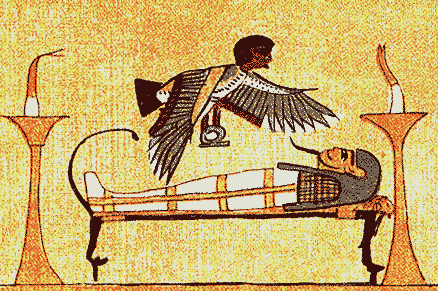
the soul released from the mummy
At first, the vignette, or a symbolic representation summarizing the intent or
content of a spell in concise pictorial form, was used for emphasis. By the
Ramesside Period, only few spells had no vignette. In the Late Period, the
vignette was used as abbreviation for an entire spell, without accompanying
text. These spells are a continuation of the Coffin Texts, available to
everyone who was someone. They remained also in use in royal tombs, namely on
tomb furnishings.
The book provisioned and protected the deceased. The "Judgement of the Dead" or
justification by the tribunal of the gods (of
Osiris) is its central theme. As
nobody entered the next world ("Duat") spotless, some spells magically purged the
deceased of his or her sin. Most magical spells affirm the deceased to be "true
of voice", i.e. found worthy at the Weighing of the Heart. Damnation being the
result of those who's heart was too heavy.
"As for him who knows this chapter, he will be a worthy
spirit in the domain of god, and he will not die again in the realm of the dead,
and he will eat in the presence of Osiris. As for him who knows it on Earth, he
will be like Thoth, he will be worshipped by the living, he will not fall to the
power of the king or the hot rage of Bastet, and he will proceed to a very happy
old age."
Book of the Dead,
chapter 135.
As with the Pyramid Texts, we cannot exclude this-life rituals
entering the collection. The fact these spells are
"beneficial to him who does it on Earth" should perhaps be taken
literally. In the course of their lifetime preparation for their meeting face to
face with Osiris, the Egyptian priests must have gone through various degrees of
initiation (reflected in the areas of the temple they could access). These
involved "seeing" Osiris in his tomb (cf. the Osireon of Seti I and seeing =
being).
"Follow
the god as far as his place,
in his tomb which is found at the entrance of the cavern.
Anubis sanctifies the hidden mystery of Osiris,
(in) the sacred valley of the Lord of Life.
The mysterious initiation of the Lord of Abydos !"
Griffith,
tomb I, 238, lines 238-239, ca.XIIth Dynasty.
If they knew the book on Earth, they were
like Thoth, worshipped by the living, and enjoying a happy old age.
"I
am a priest knowledgeable of the mystery,
who's chest never lets go what he has seen !"
Chassinat,
1966, pp.11-12.
3 The
Papyrus of the Adoration of Re
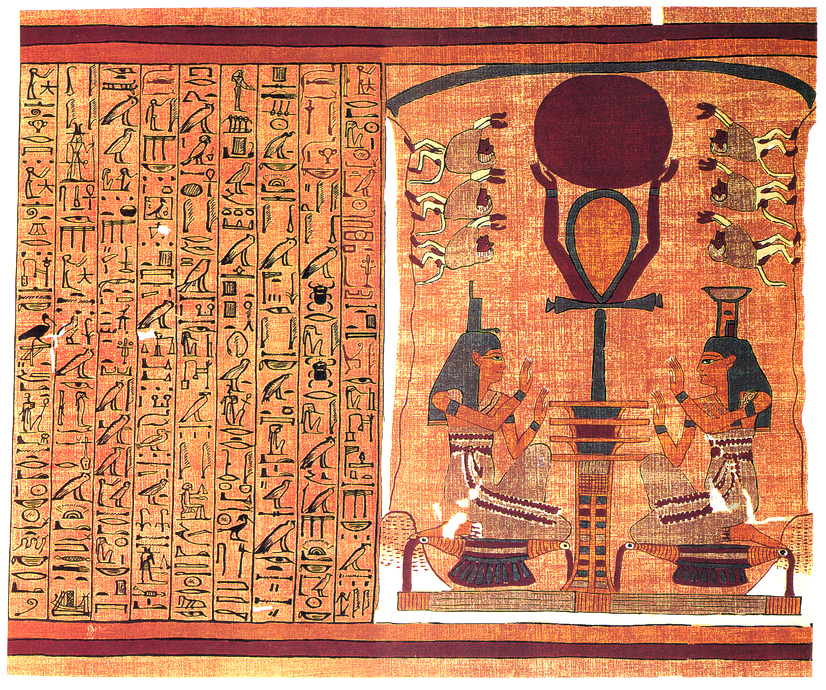
Papyrus of Ani : hymn : the Adoration of Re
(beginning)
The text of the
Adoration of Re starts with the title of the piece and its author in the right upper corner :

The vignette is a
symbolic representation of the intent of a spell in a concise pictorial
form. This complements the text. Here, the vignette depicts the
"Two Ladies", namely Isis and Nephthys, the traditional mother-deities
already figuring in the earliest texts (cf.
The Pyramid Texts
of Unas). Their presence in this oldest religious corpus
underlines the assimilation of the Neolithic Great Mother Goddess by the
divine king, the Follower of Horus and the Son of Re. Nevertheless, just
as the political power of the female side of the "Great House" was
unmistaken throughout the long history of Pharaonic Egypt, these
mother-deities remain part of the iconography of the divine king and part of the mortuary liturgy of non-royals (cf. Ani is depicted
together with his wife). This mutual
interdependence of Solar and Lunar symbols is the core of Ancient
Egyptian soteriological concerns. With Dynastic Egypt, the Solar power was
overt, the Lunar power concealed. But as all things hidden (the
Nun, the
Amduat of
Osiris, the Lunar),
it remained potent and everlastingly present as the hidden matrix
nurturing nature and the Nile flood.
The "Two Ladies" are part of the myth of Osiris, providing pivotal help
by lamenting his death, seeking his parts, rejuvenating him, nurturing
Horus the Child, etc. Here, we see them in the moment of worshipping the
symbol of an Ankh birthing a Sun Disk, symbol of the renewal of Re's
life-force, mounted upon a Djet Pillar, representing the everlasting
stability offered by Osiris by virtue of the nocturnal & Lunar passage
from West to East (cf. the "Books of the Underworld"). The "new" life in
question is the renewal of the Sun in the "akhet", the Eastern horizon, as
represented by the six Baboons (representing Thoth), shouting at the
rising Sun.
The emblem represents
the synthesis of the Solar (Re) and Lunar (Osiris) orders of Ancient
Egyptian soteriology :
-
STARTING WITH THE MOON : the
(lower) sky of Osiris (the Eye of Horus) : the ultimate state of human
blessedness is to live the life of an "Osiris NN", with a court,
humbling servants and a kingdom situated in the vast darkness of the
Duat (like creation is a bubble of moist air suspended in chaos). Even
the smallest offer made with a sincere heart during earthly life might
be enough to be helped by Isis or Osiris, and so the commoners made sure
the holy family noticed them. This economy is inclusive of
everyman, but conditional. The only exception to it was Pharaoh ;
-
ENDING IN THE SUN : the (upper)
sky of Re (the Eye of Re) : the sky of Osiris and the sky of Re are proximate,
and after the highest spirituality of servitude has been fulfilled, the
"Ba" or soul of the deceased is transformed, in the horizon, into an "Akh"
or spirit of
Re, sailing, among the other pure beings of light, on the Bark of Re,
illuminating the beings of day and night, including the deities and the
justified blessed dead of Osiris (who otherwise sleep). The sacred
knowledge regarding this spiritual evolution was for the very few and,
when first written down, portrayed in the tomb of kings
only. This economy is exclusive of everyman, reserved to the deities (as
the king and his high priests) and unconditional.
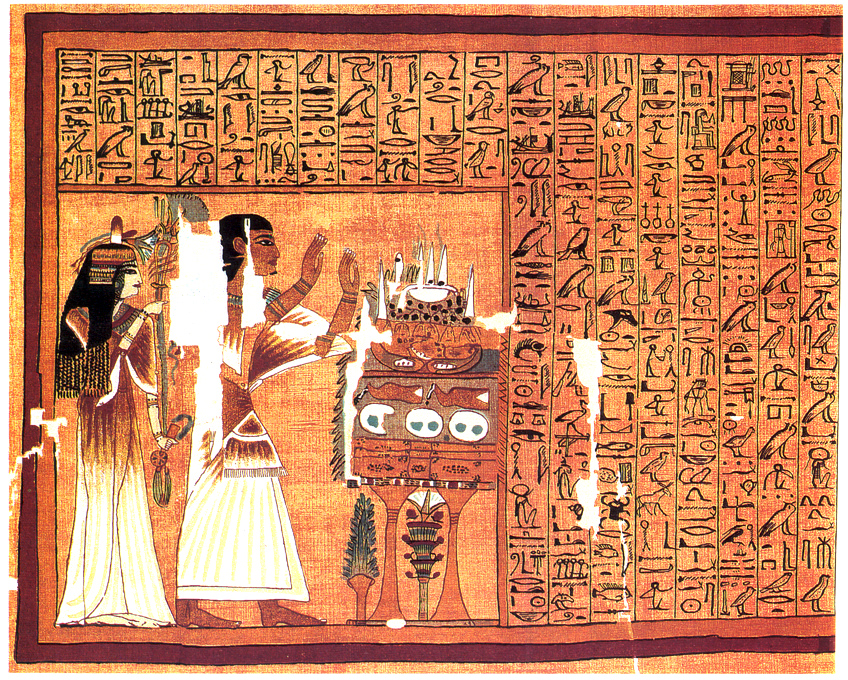
Papyrus of Ani : the Adoration of Re
(end)
"May my name be proclaimed when found upon the board of offerings ;
may my food offerings be given in my presence like (to) the Followers of
Horus."
The vignette depicts Ani
and his wife, offering to the gods before a board of offerings.
4
The Hieroglyphs of the Hymn
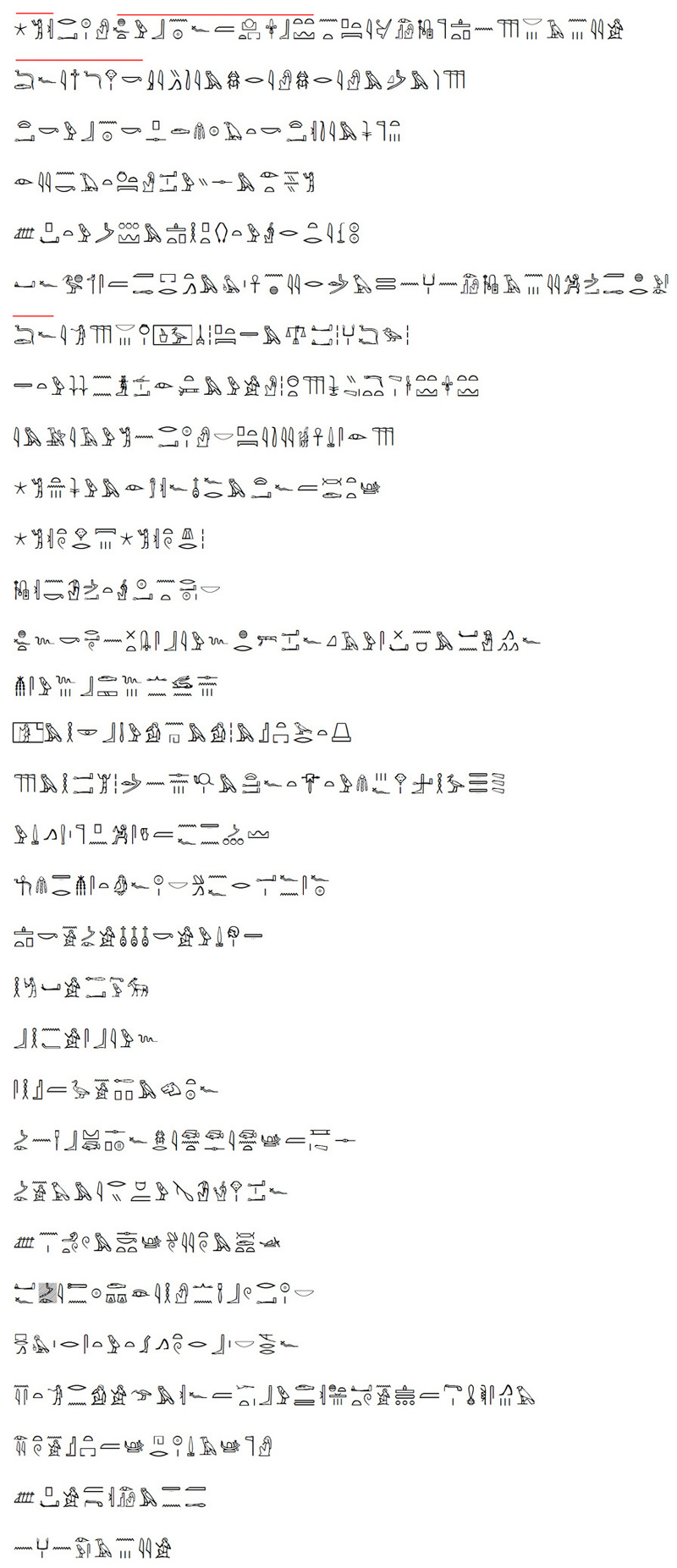
|

![]()
